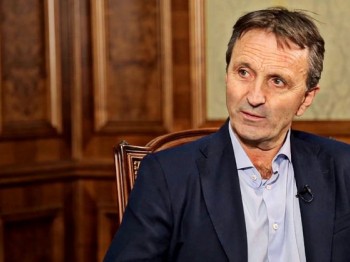Electricity needs to be sold like meat or vegetables – the head of a Norwegian energy company
The head of Norway's AICE Hydro, Arne Jakobsen, says that rules in the renewable energy sector should not change every 2 years.

The head of Norway's AICE Hydro, Arne Jakobsen, says that rules in the renewable energy sector should not change every 2 years.
Arne Jakobsen, the head of a major hydroenergy producer in Norway, AICE Hydro AS, talks about how Ukraine can reform its electricity market to make it compliant with European rules and more appealing to investors.
This year, the new Law on the Electricity Market was adopted in Ukraine, requirements of which are coordinated with the requirements of EU legislation, in particular, the Third Energy Package.
Energorynok, which is currently the operator of Ukraine's Unified Electricity Market, i.e. regulates all flows of electricity and funds, announced that it has already established two divisions that will become new operators after the reform. These are the next-day market operator and a state enterprise, the guaranteed buyer.
The next-day market will be based on the principles of marketplace trading: the price of power will be set for the next day. Also, an intra-day market will be established within this operator.
According to Energorynok director Yuriy Gnatyuk, the enterprise is considering using the Norwegian market operations algorithm.
How is the Norwegian electricity market actually structured? NV Business decided to ask Arne Jakobsen, the chairman of the board of AICE Hydro AS, a major hydro energy producer in Norway.
– Why develop hydro energy around the world in the first place? What are the benefits?
– This is renewable energy, among the best known and most widely used in the past. A familiar technology. Traditionally, it has been cheaper than other, newer renewable energy sources. Water energy has vast potential that we can harness. Hydro energy is a natural resource that we can use.
– In Ukraine, some think that hydro energy is more expensive than nuclear energy, for example.
– I would disagree that it's more expensive. Especially if you consider the possible consequences of a catastrophe (at a nuclear plant – ed.). Currently, water is one of the cheapest forms of energy production. So I would not agree with this.
– Could you please tell us how the electricity market is structured in Norway? Who sets the tariffs? Who regulates the market?
– In Norway, the market is liberalized. It was deregulated as the result of reform. Producers sell electricity to consumers right at trading platforms. This market is similar to a one where you buy meat, vegetables, and so on. Every day at noon, the price of electricity is set for the next 24 hours at an auction.
However, the country has what are called critical sections: some areas produce more energy, some areas less. Major cities consume more than rural areas. In some regions, there are more generating facilities but consumption is less, so their prices are lower. In other regions, the situation is the opposite: they produce small amounts of energy but consume more, so the prices are higher. In Norway, prices can be different in different regions. This is why such auctions set not only an hourly price, but an hourly price for a certain region. There are 4–5 price regions in Norway.
– For us this is simply incredible, as we have regulation here. What is today's tariff for hydro energy in Norway? Are you happy with it?
– The price in Norway is low, 40.3 oere per kWh, since we have excess energy. The tariff is the same for all producers; it doesn't matter it's gas or hydro energy.
Electricity in Norway is mainly produced by hydro stations. Also, for small hydro stations, which we're developing, or if it's a new renewable energy station, Norway provides for what we call a green certificate, which you can sell and get extra value.
– How should Ukraine reform the electricity market to bring it into compliance with European rules?
- A lot has to be done. I think the most important thing is to ensure a stable overall structure long-term. Stable conditions, stable prices – in this case, prices for renewable energy. This condition should be in place not just for the next 10 years, but for the next 20–30.
Electricity generation is a cost-intensive industry. Vast investments are required immediately, but it will take several years to see a return. Fast changes – from prices for renewable energy to auctions – investors hate that.
– What should the share of alternative energy be, including hydro energy, in the Ukrainian fuel and energy sector?
– Ideally, 100%. But in practice, a realistic goal would be 10-15%. If you achieve 12%, that would be a big step. Ideally, every country should try to achieve 100%.
– What needs to change in the market, and what reforms do there need to be to make it more appealing to investors?
- Three things need to be done: Corruption needs to be eliminated, the licensing process simplified (which is rather easy to do), and stability ensured (which is also easy).
In Ukraine, the process of obtaining licenses to create renewable energy facilities is still too complicated and bureaucratic, so this process has to be simplified.
You just have to tell the politicians not to intervene, to leave everything as it is. If you do change something, you should notify the industry in advance, then do it and back off. In this sector, you shouldn't be changing the rules every two years.
